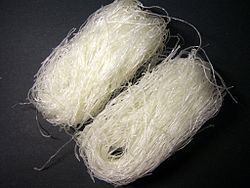Cellophane noodles

Dried cellophane noodles
|
|
| Alternative names | Chinese vermicelli, bean threads, bean thread noodles, crystal noodles, glass noodles |
|---|---|
| Type | Chinese noodles |
| Place of origin | China |
| Main ingredients | Starch (from mung beans, yams, potatoes, cassava, canna or batata), water |
| |
|
| Cellophane noodles | |||||||||||||||
| Chinese name | |||||||||||||||
|---|---|---|---|---|---|---|---|---|---|---|---|---|---|---|---|
| Traditional Chinese | 1. 粉絲 2. 冬粉 3. 細粉 4. 線粉 |
||||||||||||||
| Simplified Chinese | 1. 粉丝 2. 冬粉 3. 细粉 4. 线粉 |
||||||||||||||
| Literal meaning | 1. powder thread 2. winter powder 3. slender powder 4. line powder |
||||||||||||||
|
|||||||||||||||
| Vietnamese name | |||||||||||||||
| Vietnamese | 1. miến 2. bún tàu 3. bún tào |
||||||||||||||
| Thai name | |||||||||||||||
| Thai | 1. วุ้นเส้น 2. เส้นแกงร้อน |
||||||||||||||
| RTGS | 1. wunsen 2. sen kaeng ron |
||||||||||||||
| Korean name | |||||||||||||||
| Hangul | 당면 | ||||||||||||||
| Hanja | 唐麵 | ||||||||||||||
|
|||||||||||||||
| Japanese name | |||||||||||||||
| Kanji | 春雨 | ||||||||||||||
|
|||||||||||||||
| Transcriptions | |
|---|---|
| Standard Mandarin | |
| Hanyu Pinyin | 1. fěnsī 2. dōngfěn 3. xìfěn 4. xiànfěn |
| Yue: Cantonese | |
| Jyutping | 1. fan2 si1 2. dung1 fan2 3. zi2 fan2 4. sin3 fan2 |
| Southern Min | |
| Hokkien POJ | 1. hún-si 2. tang-hún 3. sè-hún 4. suànn-hún |
| Transcriptions | |
|---|---|
| Revised Romanization | dangmyeon |
| Transcriptions | |
|---|---|
| Romanization | harusame |
Cellophane noodles (/ˈsɛləˌfeɪn/; also known as Chinese vermicelli, bean threads, bean thread noodles, crystal noodles, or glass noodles) are a type of transparent noodle made from starch (such as mung bean starch, yam, potato starch, cassava, canna or batata starch) and water.
They are generally sold in dried form, soaked to reconstitute, then used in soups, stir fried dishes, or spring rolls. They are called "cellophane noodles" or "glass noodles" because of their appearance when cooked, resembling cellophane, a clear material of a translucent light gray or brownish-gray color.
Cellophane noodles are generally round, and are available in various thicknesses. Wide, flat cellophane noodle sheets called mung bean sheets are also produced in China.
Cellophane noodles should not be confused with rice vermicelli, which are made from rice and are white in color rather than clear (after cooking in water).
Cellophane noodles are made from starch (from mung beans, yams, potatoes, cassava, or canna). In China, cellophane noodles are usually made of mung bean starch.
...
Wikipedia
